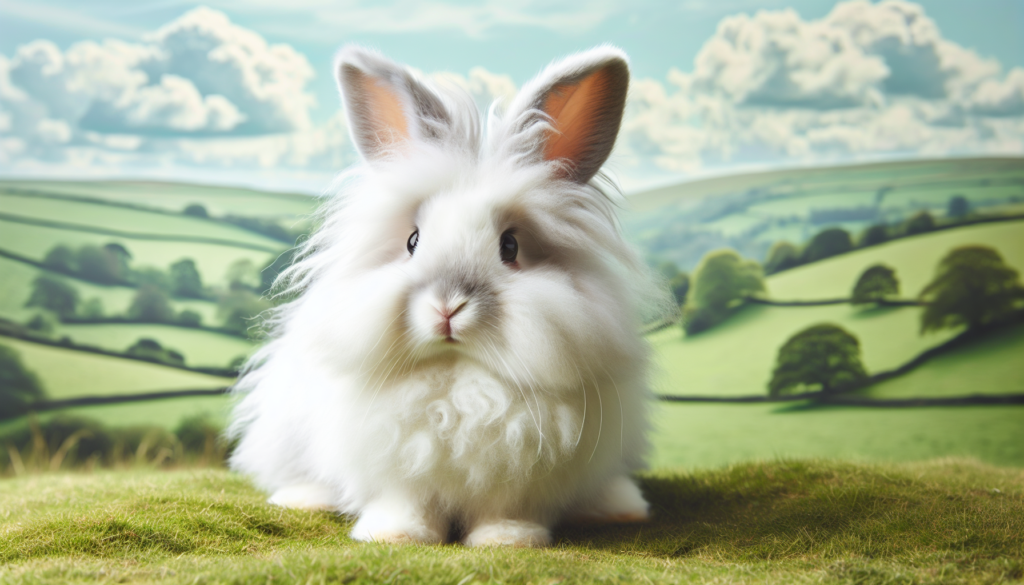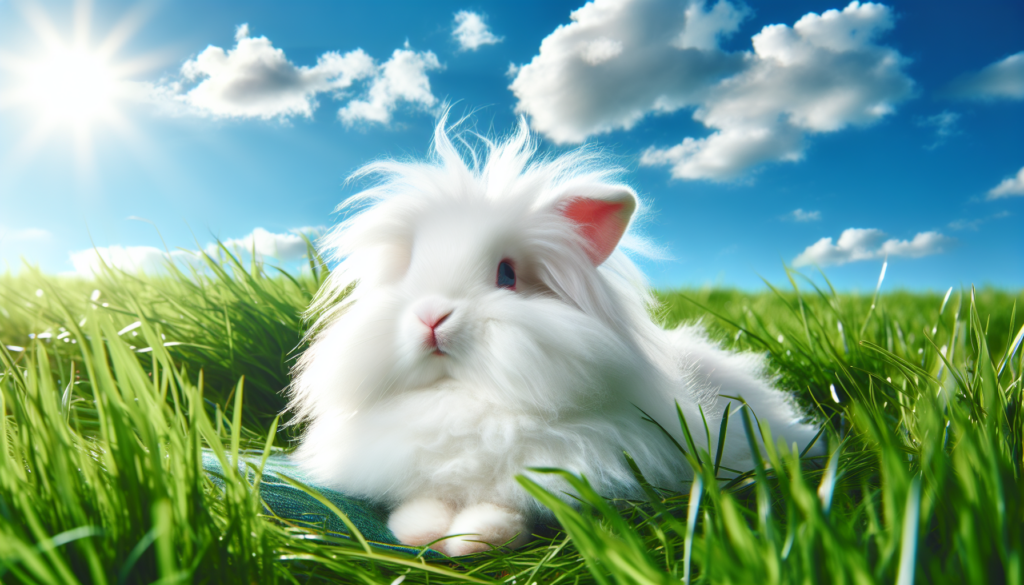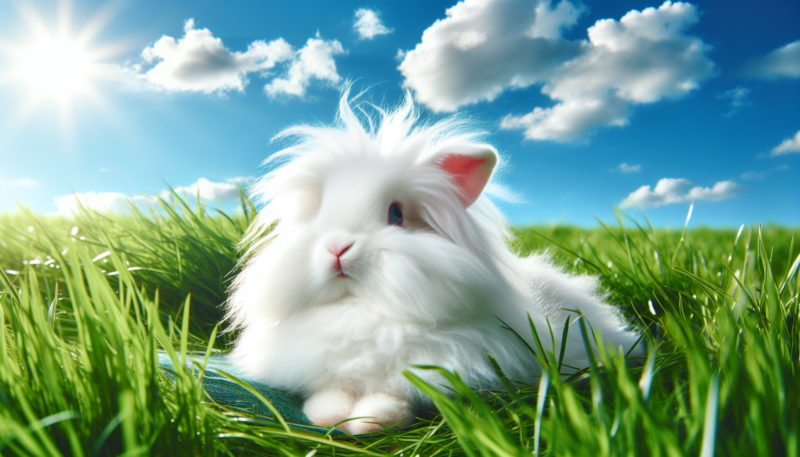Did you know that English Angora rabbits have some fascinating features that set them apart from other breeds? From their luxuriously soft fur to their gentle and sociable nature, these fluffy creatures have captured the hearts of many. In this article, we will explore 10 fun facts about English Angora rabbits that will leave you amazed and wanting to learn more about these adorable and unique animals. So, get ready to discover some fascinating quirks and characteristics of this charming breed.
Appearance and Size
Long, soft wool
The English Angora rabbit is known for its long, soft wool. Its coat is filled with luxurious fibers that are incredibly soft to the touch. This high-quality wool sets the English Angora apart from other rabbit breeds and makes them highly sought after by fiber artists and enthusiasts. The wool is typically harvested by carefully clipping or shearing the rabbit’s coat.
Large and fluffy
These adorable rabbits are large in size, with adults weighing between 5 to 9 pounds. Their body shape is compact and muscular, adding to their overall charm. However, it is their fluffy appearance that truly captivates everyone’s attention. The English Angora’s wool extends all over its body, giving it a rounded and puffy appearance. This makes them incredibly cuddly and a delight to have as pets.
Variety of colors
English Angora rabbits are available in a wide variety of colors. From pure white and cream to black, blue, chocolate, and even tortoiseshell, there are numerous color options to choose from. The fur can also have different patterns, including solid, broken, and shaded. This diversity in colors and patterns allows for a wide range of choices when it comes to selecting an English Angora rabbit as a pet or for breeding purposes.
Origin and History
Originated in Ankara, Turkey
The English Angora rabbit is a breed that originated in Ankara, Turkey, which was formerly known as Angora. The breed’s name derives from the city, which has a long history of producing high-quality wool. For centuries, the Turkish people selectively bred rabbits with long, soft, and fine fur to develop the Angora breed. These rabbits were highly prized for their luxurious wool, which was traditionally used to make clothing and accessories.
Brought to Europe in the 18th century
In the 18th century, English sailors and traders brought Angora rabbits from Turkey to Europe. There, the breed gained popularity among the wealthy and noble classes as a symbol of luxury and refinement. The English Angora rabbits were further developed in Europe through selective breeding, which resulted in improved wool quality and variety of colors.
Recognized by ARBA in 1938
The American Rabbit Breeders Association (ARBA) officially recognized the English Angora breed in 1938. This recognition solidified the breed’s status among rabbit enthusiasts and breeders. Today, English Angoras are widely recognized and valued for their beautiful appearance, docile nature, and exquisite wool.

Temperament and Behavior
Gentle and docile
English Angora rabbits have a reputation for being gentle and docile. They are known for their calm and friendly personalities, making them wonderful companions and pets. They are generally not aggressive and are often quite sociable with humans and other animals. Their gentle nature makes them suitable pets for families and individuals seeking a calm and loving companion.
Intelligent and curious
These rabbits are not only gentle but also highly intelligent and curious. They have the ability to quickly learn and understand their surroundings. English Angoras love exploring their environment and are always eager to investigate new things. Their intelligence and curiosity make them engaging pets to interact with, as they enjoy mental stimulation and environmental enrichment.
Enjoy human companionship
English Angora rabbits are known for their love of human companionship. They thrive in social settings and enjoy being around their owners. They are often described as affectionate animals that form strong bonds with their caregivers. Spending quality time with an English Angora, whether through gentle petting, playtime, or simply sitting nearby, can strengthen the bond between the rabbit and its owner.
Grooming and Fur Maintenance
High maintenance fur
The English Angora’s long, fluffy wool requires regular grooming and maintenance. Their fur can easily become tangled or matted if not properly cared for. Grooming includes brushing the wool to prevent matting and removing any debris or foreign objects that may get caught in the fur. Rabbit-safe grooming tools, such as a slicker brush or wide-toothed comb, are recommended for maintaining the English Angora’s beautiful coat.
Regular grooming required
To keep the English Angora looking its best, regular grooming sessions are necessary. These sessions should be scheduled at least once a week, or even more frequently depending on the rabbit’s coat condition. Grooming not only ensures the cleanliness and health of the fur but also gives owners an opportunity to bond with their furry companion. It is important to approach grooming sessions calmly and gently to keep the rabbit at ease.
Angora wool can grow up to 3 inches per month
One fascinating characteristic of the English Angora’s wool is its rapid growth rate. The fur can grow up to 3 inches per month, making regular grooming even more essential. If the wool is left unattended, it can quickly become unmanageable and lead to discomfort for the rabbit. Regular grooming helps prevent matting, tangling, and fiber breakage, ensuring that the rabbit’s coat remains in optimal condition.

Health and Lifespan
Generally healthy breed
English Angora rabbits are generally healthy animals, but they are still susceptible to certain health issues. It is important to ensure a proper diet, regular veterinary check-ups, and a clean living environment to promote a healthy lifestyle for these rabbits. Owners should be mindful of any changes in behavior, appetite, or physical appearance and promptly seek veterinary care if any concerns arise.
Lifespan of 7-12 years
English Angora rabbits have an average lifespan of 7 to 12 years when provided with proper care and nutrition. Attention to the rabbit’s overall well-being, including a balanced diet, regular exercise, and a stress-free living environment, can contribute to a longer and happier life. Engaging with the rabbit through interactive playtime and mental stimulation can also promote a healthy and enriched lifestyle.
Prone to dental problems
One health concern for English Angora rabbits is dental problems. Their teeth continuously grow throughout their lives, and if not properly worn down, they can become overgrown or misaligned. This can lead to difficulties in eating, dental pain, and even dental abscesses. Regular veterinary check-ups and providing appropriate chewing toys and fibrous foods can help maintain good dental health for these rabbits.
Diet and Nutrition
Herbivorous diet
English Angora rabbits, like all rabbits, have a herbivorous diet. Their digestive system is specially designed to process fibrous plant materials. A diet composed primarily of high-quality hay, fresh vegetables, and a limited amount of pellets and fruits is essential for maintaining optimal health for these rabbits. It is important to ensure that the rabbit’s diet is well-balanced and provides all the necessary nutrients.
Fresh hay and vegetables
The foundation of an English Angora’s diet should be fresh and high-quality hay. Hay provides essential fiber for proper digestion and helps wear down the rabbit’s continuously growing teeth. Alongside hay, a variety of fresh leafy greens and vegetables should be included in the rabbit’s daily meals. These can include dark leafy greens, such as kale and spinach, as well as herbs like parsley and cilantro.
Limited pellets and fruits
While pellets and fruits can be part of an English Angora’s diet, they should be given in limited quantities. Pellets should be specifically formulated for rabbits and should not make up the majority of their diet. Too many pellets can lead to obesity and other health issues. Similarly, fruits should only be given occasionally as treats due to their high sugar content. It is important to monitor the rabbit’s weight and adjust its diet accordingly.
Breeding and Reproduction
Mature around 7-12 months
English Angora rabbits typically reach sexual maturity around 7 to 12 months of age. It is important to wait until the rabbits have fully matured before considering breeding, as breeding too early can have negative health effects. It is advisable to consult with an experienced breeder or veterinarian to ensure that the rabbits are in optimal health and ready for breeding.
Gestation period of 28-32 days
The gestation period for English Angora rabbits lasts approximately 28 to 32 days. During this time, the female rabbit, known as a doe, will carry the developing kits in her womb. It is important to provide the doe with a clean and comfortable nesting area and monitor her closely for any signs of complications or distress. Adequate nutrition and veterinary care throughout the gestation period will contribute to a successful and healthy delivery.
Litter size can range from 2-10 kits
English Angora rabbits can have litters ranging from 2 to 10 kits, although the average litter size is usually around 6 to 8 kits. The doe will usually care for and nurse the kits on her own, providing them with the necessary nourishment for their early development. It is important to provide a secure and warm nesting area for the kits, ensuring their safety and well-being. Consulting with a breeder or veterinarian can provide valuable guidance during the entire breeding and reproduction process.
Physical Activity and Exercise
Require regular exercise
English Angora rabbits, despite their docile nature, require regular physical activity and exercise. Providing them with opportunities to stretch their legs and engage in playful activities is crucial for their overall well-being. Regular exercise helps prevent obesity, strengthens their muscles, and promotes good mental health. Owners should provide a safe and supervised area for the rabbit to exercise and explore.
Playtime and gentle handling
English Angora rabbits enjoy playtime with their owners. They can be easily entertained with toys, tunnels, or simple games of hide-and-seek. Gentle handling and interaction are essential during playtime to ensure the rabbit feels safe and secure. It is important to provide a calm and stress-free environment during play sessions, as rabbits are sensitive animals that can easily become overwhelmed.
Love exploring and hopping around
One of the English Angora’s favorite activities is exploring and hopping around. These rabbits have a natural curiosity and enjoy investigating their surroundings. Owners can encourage this behavior by creating a safe and rabbit-proofed space for the rabbit to roam freely. Supervised exploration time not only provides physical exercise but also mental stimulation, keeping the rabbit engaged and happy.
Suitability as Pets
Good for families
English Angora rabbits make wonderful pets for families. Their gentle nature and affectionate personalities make them great companions for individuals of all ages. They thrive in social environments and enjoy interacting with their human family members. Caring for an English Angora can be a rewarding experience for both children and adults, fostering responsibility, empathy, and companionship.
Require gentle handling
Due to their delicate nature, English Angora rabbits require gentle handling. Their long, flowing fur is prone to matting and tangling, so it is important to approach them with care. When picking up or holding an English Angora, it is advisable to support their body properly, including their hindquarters. This reduces the risk of accidental injury and ensures the rabbit feels secure and comfortable.
Not recommended for young children
While English Angora rabbits can be great pets for families, they may not be suitable for very young children. Their long fur requires consistent grooming and maintenance, which may be challenging for young children to handle responsibly. Additionally, the rabbit’s delicate nature and need for calm and gentle interaction may not align with the energy and exuberance of young children. It is important to assess the individual needs and capabilities of the family and children involved before bringing an English Angora into a household with young children.
Show and Competition Qualities
Regularly shown in rabbit shows
English Angora rabbits are regularly showcased in various rabbit shows and exhibitions. These events provide an opportunity for owners and breeders to display their rabbits’ beautiful fur and conform to breed standards. Showing English Angoras allows them to be evaluated by judges who assess their fur quality, conformation, and overall presentation. Participating in rabbit shows can be an exciting experience for both the owner and the rabbit.
Judged based on fur quality and conformation
When competing in rabbit shows, English Angoras are judged primarily based on their fur quality and conformation. The wool is carefully examined for its softness, density, and uniformity. Judges also evaluate the rabbit’s overall body structure, including its posture, size, and proportion. Attention to grooming and presentation is crucial in showcasing the English Angora’s exquisite wool and ensuring a successful showing.
Can participate in wool contests
In addition to general rabbit shows, English Angora rabbits have the opportunity to participate in wool contests specifically dedicated to assessing the quality of their fur. These contests focus solely on the wool itself, evaluating attributes such as fineness, length, and uniformity. Winning in these contests can be a testament to the breeder’s dedication and skill in producing top-quality English Angora wool.
In conclusion, English Angora rabbits are a delightful breed known for their long, soft wool, large and fluffy appearance, and a variety of colors. They originated in Ankara, Turkey, and were brought to Europe in the 18th century, gaining recognition from ARBA in 1938. The English Angora’s temperament is gentle and docile, with an added touch of intelligence and curiosity. Regular grooming is essential, given the high maintenance nature of their fur, and they have a lifespan of 7 to 12 years. English Angoras thrive on a herbivorous diet and require regular exercise and gentle handling. They make great pets for families, but caution is advised with young children. Additionally, these rabbits participate in rabbit shows, where they are judged based on fur quality and conformation, as well as wool contests dedicated to showcasing their exquisite wool. Overall, English Angora rabbits offer a unique and rewarding pet experience for those willing to care for and appreciate their remarkable qualities.
